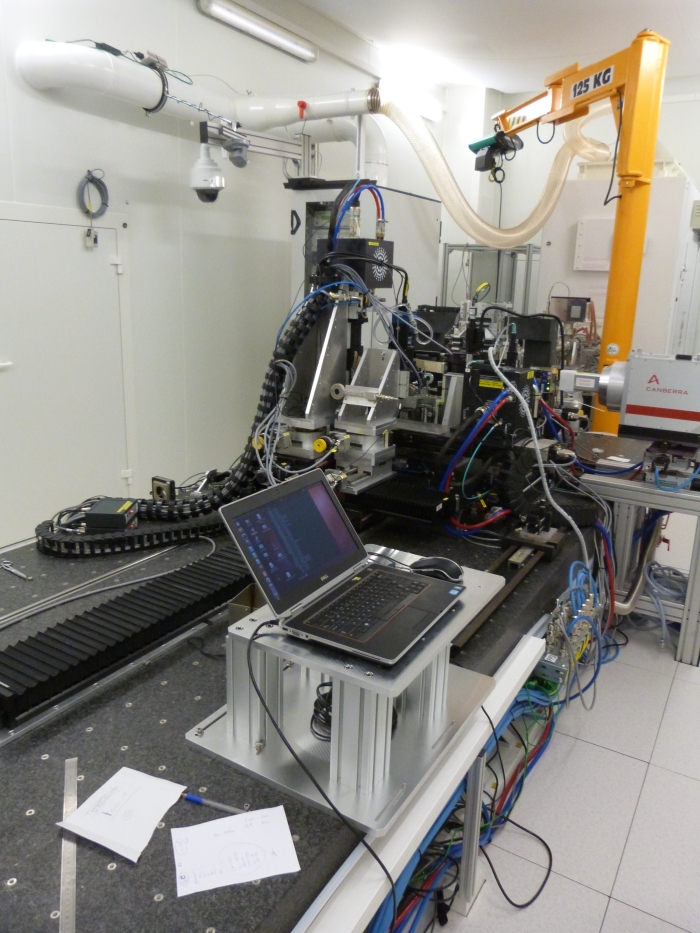
When viewed from the imposing ramparts of Fort de la Bastille, from a great height and at a distance of about 2 km, The European Synchrotron Research Facility (ESRF)* in Grenoble seems tiny. With one eye closed it can be easily viewed through the space encircled by a curled index finger and thumb.
As I stand here above the city, light rays from the setting sun – which has provided a constant 20-30 degrees of heat during my time in France – are hitting the circular arena of the synchrotron building. They are nearing the end of their 149.6 million km journey from our star, and some will very soon be passing into my retina through a tiny star-shaped aperture encompassed by two folded human digits.
Grenoble, capital of the department of Isère and advertised as ‘The Capital of the Alps’ is surrounded by massive bastions of layered limestone, formed by the skeletal remains of uncountable billions of microscopic organisms laid down over millions of years. This is a landscape in which the forces of nature are expressed in what a painter’s eye might interpret as broad, expressionistic brush-strokes. The processes of orogenesis – mountain forming – and erosion that have formed this landscape is still tangible and ongoing, as evidenced by recent earthquakes, although these processes are occurring at less of a pace than at the end of the last ice age, when vast quantities of glacial melt water flooded this valley.
The ESRF is nestled between the arms of the two great rivers that remain from these floods: the Isère and Le Drac. When I was speaking with Andrew Dennison at coffee this morning – Andrew, from Manchester, is a biophysicist who has been working at the adjoining ILL (Institut Laue-Langevin) for over two years and is part of our team – I discovered that the facility is powered by hydroelectricity, by the force of gravity.
It is easy to feel small here, easy to fall into awed contemplation of the relatively diminutive scale and form of a human life.
How any beetles can dance on the point of a needle? … a description of the experiment
I am with Andrew Dennison and two young researchers from the University of Sheffield, Stephanie Burg and Adam Washington. Both are originally from the USA but have studied in the UK. Stephanie has brought with her a box full of specimens: tiny beetle scales measuring no more than 0.2mm in width, a scale from an iridescent butterfly wing that is even tinier, and a miniscule fragment of a jay feather. These incredibly fragile specimens are to be placed within a beam of x-rays generated by bending the passage of electrons that speed in continuous circular motion around a vast hall – the synchrotron.

The x-ray beam itself, as it emerges from this orbital race, is tiny in circumference; far smaller than the aperture through which I was viewing this self-same hall from the walls of the Bastille, and it must be perfectly aligned with our minuscule specimen.
Alignment takes place within a robot controlled environment called the experiment hutch. It is a clean room so gowns and disposable shoe coverings must be worn before entering. The room must be entered to mount the sample in the beam line. An elaborate system of safety checks ensures that no one is left behind in the room when the shutter that opens the beam aperture is unlocked. This elicits a strange, superstitious anxiety about the possibility of x-rays lingering dangerously in the room, like the aftermath of a cast spell.
It is a work of painstaking skill to align the first specimen within the beam. The beetle scale will be sliced into 3,000 scanned layers in two perpendicular planes and it is of great importance that the structures that we are examining are displayed at the correct angle: the angle at which light enters and leaves the photonic crystals, becomes scattered and, in the case of Lepidiota stigma, produces structural colour – in this case a sensation of the whitest white.
‘Beam time’ has been booked for 3 days – from 31st August until the 2nd of September. During this time the scientists must work all hours at the will of the machine, catching a couple of hours of fragmented sleep every now and again when the process of capturing data becomes automated by Adam’s ‘macros’ or code scripts. Handling tasks of such enormous precision and delicacy after very little sleep is arduous work …
Next: … and they shall beat their swords into plowshares … a visit to the reactor hall
* The European Synchrotron Radiation Facility (ESRF) is a joint research facility that is supported by 21 countries (13 member countries: France, Germany, Italy, UK, Spain, Switzerland, Belgium, The Netherlands, Denmark, Finland, Norway, Sweden, Russia and 8 associate countries: Austria, Portugal, Israel, Poland, Czech Republic, Hungary, Slovakia, South Africa).
The ESRF physical plant consists of two main buildings: the experiment hall, containing the 844 metre circumference ring and forty tangential beamlines; and a block of laboratories, preparation suites, and offices connected to the ring by a pedestrian bridge. The linear accelerator electron gun and smaller booster ring used to bring the beam to an operating energy of 6 GeV are constructed within the main ring. Until recently bicycles were provided for use indoors in the ring’s circumferential corridor. Unfortunately they have been removed after some minor accidents. But even before this it was not possible to cycle continuously all the way around, since some of the beamlines exit the hall.
Research at the ESRF focuses, in large part, on the use of X-ray radiation in fields as diverse as protein crystallography, earth science, palaeontology, materials science, chemistry and physics. Facilities such as the ESRF offer a flux, energy range and resolution unachievable with conventional (laboratory) radiation sources.
